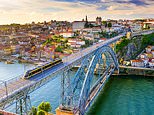
Rivalry is no bad thing between cities. The one involving Porto and Lisbon is a case in point.
‘Traditionally, Porto always made the money and Lisbon spent it,’ is what our guide tells us.
What’s undeniable is that the country’s second largest city is on a roll — having been declared a World Heritage Site, with millions of euros invested in restoring old buildings, and restaurants and bars taking advantage of a vibrant young crowd and an increasing number of direct flights from the UK.
Porto, above, has been declared a World Heritage Site, with millions invested in restoring old buildings
Let’s go walkabout
Pack suitable shoes because the best way to see the city is on foot. There are trams and buses — and taxis are cheap — but the centre of Porto is compact.
All you need is a good map or app. Summers are hot, so spring and autumn is when you should go. My only regret is not adding an extra day to cruise down the Douro and admire the terraced vineyards.
A premier bookshop
We book a guide through Oporto Prime and spend a morning with Susana Reis, who has a fascinating perspective on the city. But we are surprised when our first stop is a book shop with a long queue of Japanese tourists (those were the days) outside it.
Livraria Lello (‘the most beautiful book shop in the world’) has been around since 1906 in a magnificent Neo-Gothic building with a central spiral staircase, stained glass windows and plaster ceiling imitating wood.
J.K. Rowling apparently was inspired by the shop while married to her Portuguese first husband and teaching English in the city.
No shortage of churches
Flamboyant 17th-century Carmelitas Church (above left), which is next to 18th-century Carmo Church (above right)
If you like the flamboyance of rococo architecture, you’ll love the 17th-century Carmelitas Church just up the hill from Lello, with acres of gold brought from Brazil. Next to it is the 18th-century Carmo Church.
Far less fussy is Clerigos Church, which has become the symbol of the city, with its tall tower (240 steps) and pink and grey marble interiors.
Then there’s the theatrical church of Sao Francisco, dating back to 1223. If you find it all a little overpowering, just remember that the Virgin Mary was made Queen of Portugal in the 17th century.
The British connection
In a word, alcohol. More specifically, port, which seems to be enjoying a renaissance, particularly among the young.
From outside the church of Sao Francisco, you look across the Douro and see ‘the highest concentration of alcohol in the world’, as Susana puts it. Churchill’s, Dow, Croft, Taylor’s, Sandeman — they’re all there and most are still owned and managed by British families.
We head for Taylor’s (founded in 1692), where you’re offered a fascinating audio guide, after which you get to sample various ports.
Join the club
Well you can’t, but you should still try to visit The Factory House, which was founded as a commercial association for British merchants living in Porto around 1654.
Today, it is run by members of the British port industry. It’s a splendid 18th-century Neo-Palladian building designed by the British consul John Whitehead.
Food for thought
The best pastel de nata (custard tarts) can be found at Manteigaria near Liberty Square, declares Mark Palmer
Unique to Porto is the francesinha, meaning ‘little Frenchie’ — but it’s nothing of the kind. Get ready for a brick of a sandwich made with pork, bacon, smoked sausage and medium-rare beef, all covered in a thick coat of cheese sauce with a fried egg on top.
The best pastel de nata (custard tarts) can be found at Manteigaria near Liberty Square — to be drunk with a glass of port. We also have a spectacular dinner at Restaurant a Brasileira (part of the Pestana collection), also off Liberty Square.
On track
New York has Grand Central, Paris the Gare du Nord — and Porto has Sao Bento, where 20,000 hand-painted tiles tell the story of the city in all its quirky glory. It must be one of the busiest concourses in the world, even though most people aren’t actually getting on a train.
Where to stay
Top of the pile (and at the top of the hill overlooking the river) is The Yeatman, but we stay at its sister hotel Infante Sagres, which is cheaper and perfectly positioned. It was built in 1951 and has just undergone extensive renovation.
The stained glass panels behind the main staircase (dating from 1945) are simply exquisite, and on the other side of the building is the trendy Vogue Café serving lethal cocktails until the early hours.
Source link
CHECK OUT: Top Travel Destinations
READ MORE: Travel News



